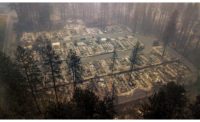The U.S. Army Corps of Engineers has declared 17 levee systems in the California Central Valley—about 180 miles' worth— ineligible for federal rehabilitation assistance should they be damaged in a flood. It cited a lack of adequate detail in a new state and local levee maintenance plan as well as inadequate inspection.
The Corps will continue to assist in emergency flood-fighting efforts on those levees but will not fund their rehabilitation after an emergency. Local and state entities will have to fill the funding gap.
The 17 systems are located in or near the cities of Sacramento, Stockton and Gustine and the census-designated places of Knights Landing, just above Sacramento, and Chester, 125 miles to the north.
The ineligible structures include 40 miles of levees that protect most of the state capital, Sacramento, population 466,488, on the American and Sacramento rivers. Twelve systems are within the boundaries of the city of Stockton, although most of those are overseen by San Joaquin County. The city of Stockton declared bankruptcy in June.
In an Aug. 21 letter, the Corps notified the California Central Valley Flood Protection Board that it had not adequately met the Corps' levee safety program requirements and that post-emergency federal rehabilitation assistance would be withheld until a more acceptable process is in place.
Bill Leady, commander of the Corps’ Sacramento District, said in a statement that even though the levee systems are currently ineligible for rehabilitation assistance, the Corps would "continue working with the state and local agencies toward long-term, sustainable improvements to levee systems in the Central Valley—and we will always be here to help in a flood."
The Corps spent $4.6 million on California levee repairs last year.
The Corps oversees 2,000 levee systems nationally. Under its USACE National Levee Safety Program, state and local government entities are responsible for identifying and planning action to correct deficiencies in channel capacity, seepage, erosion, encroachments and vegetation.
The Corps' problems with the California board's plans, which have been in development for several years for the board's entire inventory of 118 levee systems, have been known about for some time, but the declaration of ineligibility for the 17 systems was held in abeyance by an agreement with the state. However, that agreement expired in June, leading to the declaration.
The plan, called the California Central Valley Flood System Improvement Framework, sets standards for levee inspections and maintenance to reduce risk from encroachments and vegetation while more comprehensive, long-term plans are made. Various state, local and federal entities have helped develop the framework in collaboration with the Corps.
George Qualley, a flood management official at the state Dept. of Water Resources, says the state and local entities had “worked hard” on all the issues brought up by the Corps and said they were “very disappointed.” Qualley says he thought the Corps would have been more detailed in its specific recommendations and in explaining how the public would be threatened by the cited deficiencies, especially encroachment issues.







Post a comment to this article
Report Abusive Comment